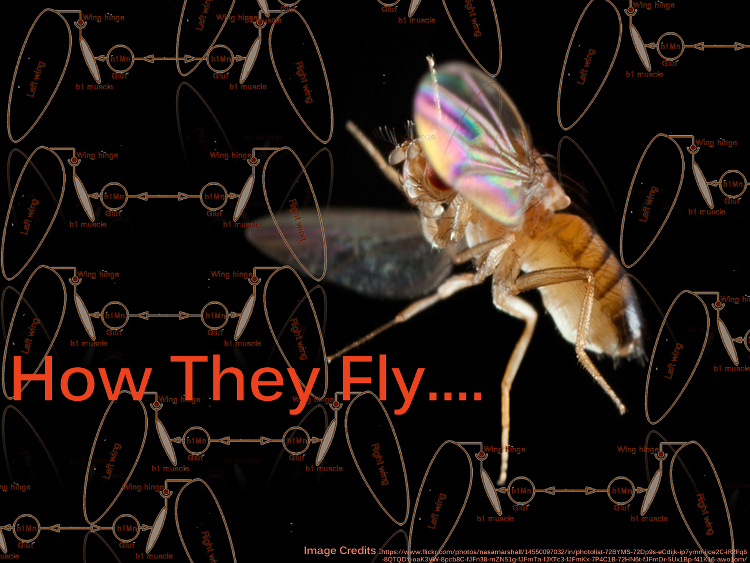How They Fly….
How They Fly….
There is a reason why they fly, a reason why they fly so high
I wonder now, I wonder how…
Flight has always been a subject of fascination for human beings but appears to be a straightforward task for a variety of animals like insects, birds and bats. Flight is an integrated behavior where multiple sensory inputs feed into a control system which fine-tunes the output. Scientists at National Centre for Biological Sciences, TIFR, Bangalore have identified components of this flight control system in flies.
This work derives from the Hasan group’s interest in identifying neural circuits underlying behavior and from the Sane lab’s interest in insect flight. “Well coordinated movement is an essential feature of animal behavior and wing movements in flies have some interesting and unusual features. Fruit flies or Drosophila, on the one hand fly by flapping both their wings in perfect coordination at frequencies greater than a 200Hz; conversely they can also flap and vibrate a single wing during courtship to produce a species specific courtship song and this behavior is an essential feature for successful mating. We are interested in understanding the neural mechanisms that allow such differential well coordinated movements which are an essential and at the same time unusual feature of animal behavior.” says Gaiti Hasan.
This recent study published in Current Biology, identifies three dopaminergic interneurons present in the ventral ganglion, that play a central role in maintenance of flight in Drosophila. Senior neuroscientist Gaiti Hasan, and PhD student Sufia Sadaf, used advanced genetic, electrophysiological techniques and behavioral assays to delineate the basis of neuronal control of coordinated bilateral wing movements in flies.
The team first identified the dopaminergic interneuron subset, which includes one unpaired neuron (VUM) and two paired neurons (a,a’), activated during flight, ascertained by the persistent calcium activity seen in response to an artificial flight stimulus. Once the nature of the neuron was identified the researchers blocked synaptic activity specifically in this set of dopaminergic neurons using two kinds of mutant transgene expression to specifically block activity in flight-activated dopaminergic neurons. Both perturbations in these interneurons lead to compromised flight activity.
For a deeper insight into the defective flight behavior, the team collaborated with Sanjay Sane who employs various advanced techniques to understand flight behavior in different insect species. Using his high speed videography set up, Sadaf captured the wing movements of flies with flight defects and found that flies with compromised dopaminergic activity show a severe inability to synchronize bilateral wing movements. Her experiments also suggested that wing coordination defects were highly specific to the dopaminergic neurons as the reduced neurotransmission in the serotonergic neurons caused no flight deficit.
Based on these experiments the researchers further hypothesized that this set of dopaminergic neuron may play a role in modulating the flight muscle motor neuron, BMn1. To test this, they obtained a transgenic glutamatergic motorneuron strain (VGlut9281(2) GAL4) from O.V. Reddy (a co-author on the paper and a graduate student of K. VijayRaghavan at NCBS), which was specific for the B1 motor neuron in the ventral ganglion. Perturbation of synaptic activity specifically in the B1 motor neurons caused flight defects similar to the defects observed in the previous experiments. These flies showed un-coordinated wing movements at the onset and cessation of flight. Thus, the neural connectivity between the dopaminergic interneurons and the motorneuron pair was established, confirming that the BMn1 receives dopaminergic inputs from the three flight modulating interneurons to control flight.
To determine whether dopaminergic interneurons modulate the B1 motorneurons for all types of wing movements, the team tested single wing movements seen during courtship and prior to mating. During courtship males exhibit patterns of unilateral wing extensions and rhythmic vibrations, which constitute the courtship song, an essential step for mating. Blocking of synaptic activity in the dopaminergic neurons had no effect on unilateral wing movements of courtship but perturbing activity in the B1 motorneuron pair led to defective courtship behavior and wing movements; indicating the modulation of the B1 motorneurons by dopaminergic interneurons is specific to bilateral wing movements for flight.
"This research was the product of collaboration between my laboratory and Gaiti Hasan's. It has allowed us to test very specific hypotheses emerging from another ongoing project which seeks to understand the biomechanical underpinnings of wing-wing coordination in flies. The results from these two projects have allowed us to clearly separate the active and passive components of wing-wing coordination, and this paper describes the active part that is mediated by a set of dopaminergic neurons that were previously undescribed." says, Sanjay Sane.
Altogether, this study demonstrates the existence of specific neuronal circuits for modulating motor neuron activity in different behavioral contexts. Moreover, the detailed understanding of cellular and neural mechanisms of wing coordination during flight may unravel various other principles of bilateral coordination, observed in the higher organisms.
The paper can be accessed here:
Neural Control of Wing Coordination in Flies
Video:Coordinated bilateral wing-flapping'

Comments
Post new comment